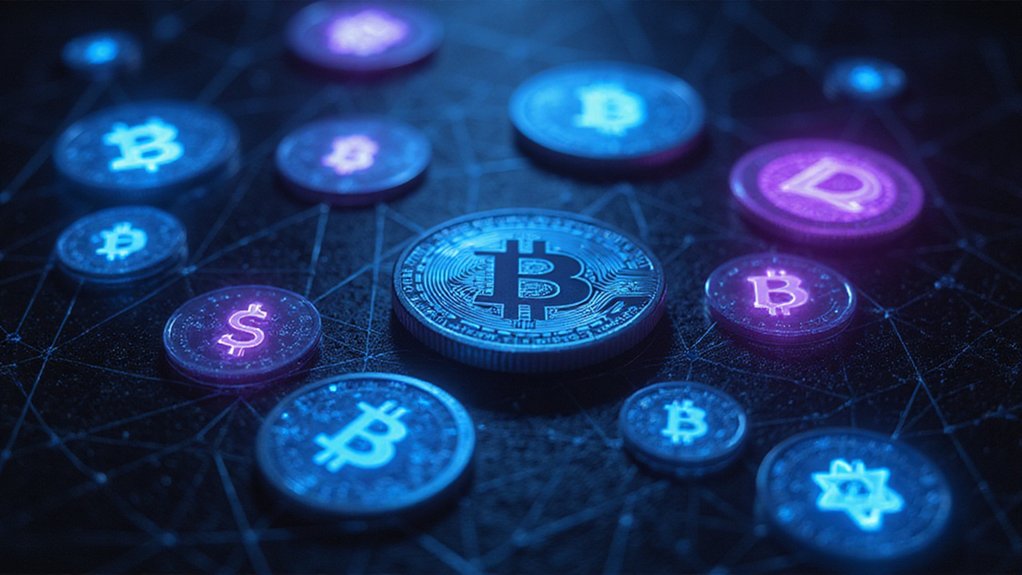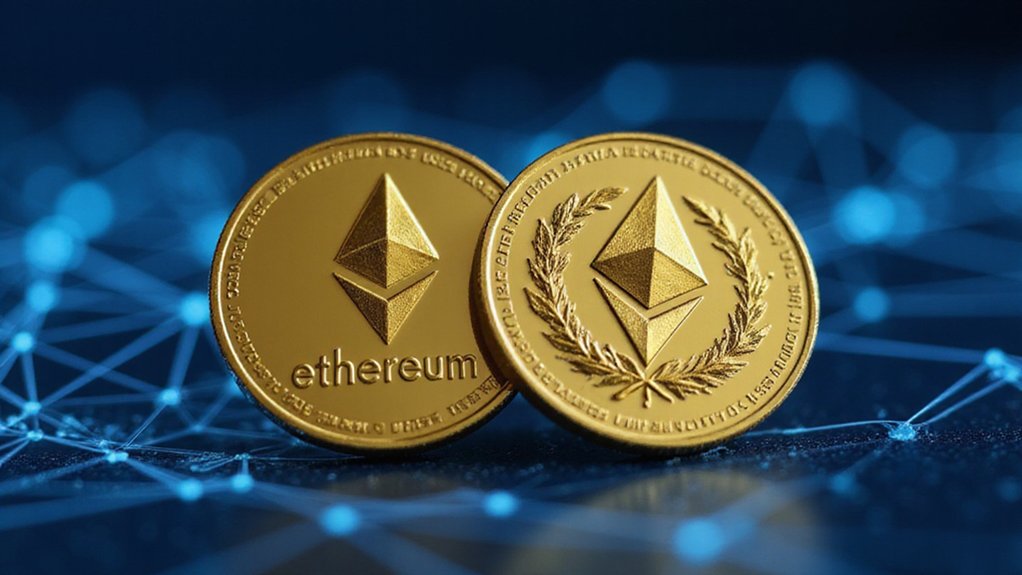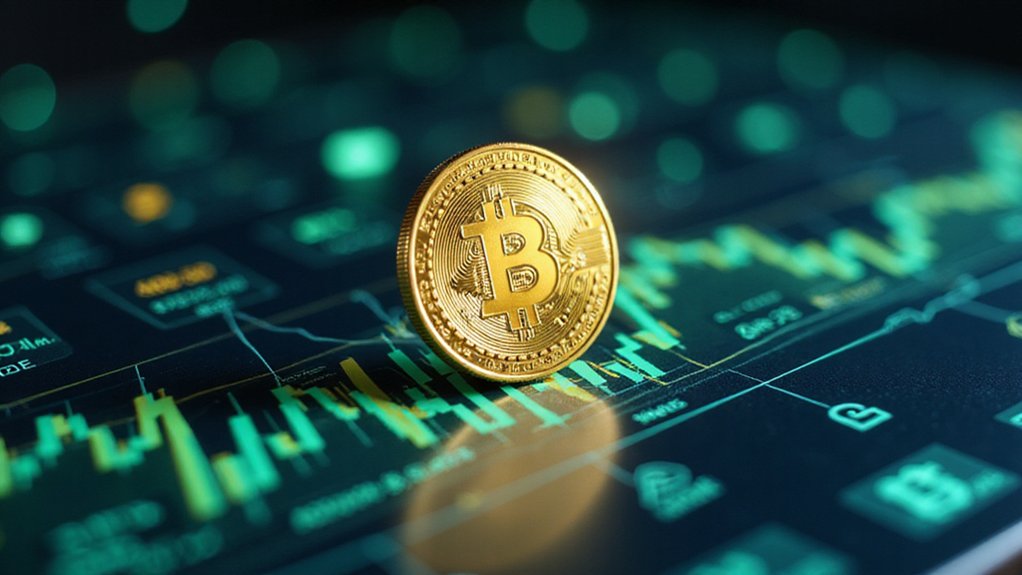Crypto tokens represent programmable units of value that transcend traditional asset categories, operating within blockchain environments via smart contracts. Unlike cryptocurrencies (which primarily function as exchange mediums), tokens enable diverse utilities including governance rights, rewards systems, and digital ownership—from fractional real estate to digital artwork. Born from Mastercoin’s 2012 innovation, these polymorphic digital assets now form the backbone of decentralized applications, incentivizing participation in what may well be the most significant evolution of value systems since paper currency.

In the increasingly complex lattice of blockchain technology, crypto tokens occupy a distinctive conceptual space—neither quite currency nor mere digital certificates, but rather programmable units of value that transcend traditional financial categorization.
These digital assets exist within blockchain environments, typically built atop established networks like Ethereum through smart contracts—those self-executing agreements with terms directly written into code.
Unlike cryptocurrencies such as Bitcoin that operate on their native blockchains, tokens leverage existing infrastructures while expanding possibilities through cryptographic security techniques including elliptical curve encryption.
The functional versatility of tokens defies simplistic classification.
They embody a spectrum of utilities: from Basic Attention Token rewarding browser users to governance tokens like MKR enabling democratic participation in decentralized financial protocols. The history of crypto tokens traces back to 2012 when J.R. Willet introduced the first token ICO through Mastercoin on Bitcoin Forum. Many tokens initially enter the market through initial coin offerings, which serve as crowdfunding mechanisms for blockchain projects.
Non-fungible tokens represent unique digital items (artwork, collectibles), whereas security tokens mirror traditional investment instruments while adhering to regulatory frameworks.
This polymorphic nature allows tokens to represent virtually anything of value—from fractional real estate ownership to voting rights in decentralized autonomous organizations.
Tokenization—the process of creating blockchain-based representations of assets—operates within networks characterized by their programmable, permissionless, and transparent architectures.
Smart contracts eliminate intermediaries by automating transactions when predefined conditions are met, creating economic and social possibilities previously unattainable in centralized systems.
The trustless environment eliminates reliance on traditional gatekeepers while maintaining transaction integrity through distributed consensus mechanisms.
Similar to tokens in other technological contexts, crypto tokens function as foundational units that facilitate access and processing within their respective blockchain ecosystems.
The distinction between tokens and cryptocurrencies extends beyond technical implementation to fundamental purpose.
While cryptocurrencies primarily function as mediums of exchange, tokens serve as programmable instruments for diverse business models and decentralized applications.
This expansive functionality enables tokens to facilitate complex interactions within digital ecosystems—from incentivizing network participation to representing ownership stakes—far exceeding the simple monetary exchange capabilities of traditional currencies.¹
Essentially, tokens represent the logical evolution of blockchain technology from digital money toward programmable value systems.
¹Though some tokens indeed function as currencies within specific ecosystems.
Frequently Asked Questions
How Do I Safely Store My Crypto Tokens?
Investors should prioritize cold wallets (hardware-based devices) for substantial holdings, utilizing hot wallets only for active trading funds.
Multi-factor authentication, encrypted keys, and regular software updates constitute the bare minimum security trifecta.
The financially prudent avoid exchange storage (where one’s tokens become theoretical assets at best), instead employing a diversified approach—hardware wallets for long-term storage complemented by software solutions for transactions.
Physical security measures shouldn’t be overlooked; after all, digital theft isn’t the only risk.
Can Tokens Be Converted Back to Traditional Currency?
Yes, tokens can indeed be converted back to traditional currency through several established channels.
Cryptocurrency exchanges—both centralized and decentralized—serve as primary conversion hubs, while peer-to-peer platforms offer direct buyer-seller connections.
Bitcoin ATMs provide tangible cash access for those preferring physical currency.
Each method carries distinct trade-offs between convenience, cost, and security.
The conversion process typically involves account verification, token transfer, and fee considerations—with regulatory compliance requirements becoming increasingly stringent for larger transactions.
What Determines a Token’s Market Value?
A token’s market value emerges from an intricate dance of supply-demand mechanics, liquidity profiles, and investor psychology.
The token’s utility within its ecosystem creates fundamental demand, while scarcity (or lack thereof) shapes supply dynamics.
Market liquidity—that elusive quality separating tradable assets from digital paperweights—determines price stability.
Meanwhile, broader sentiment, technological prowess, governance structure, and even the occasional celebrity tweet can send valuations spiraling in directions that would make traditional economists blanch.
Are Crypto Tokens Regulated by Governments?
Crypto tokens exist in a regulatory patchwork that’s as fragmented as the blockchain itself.
Multiple U.S. agencies claim jurisdiction—the SEC for security-like tokens, the CFTC for those functioning as commodities—while enforcement outpaces formal rulemaking.
Internationally, approaches range from the UK’s embrace of crypto as regulated financial instruments to outright bans elsewhere.
This regulatory ambiguity (seemingly by design?) creates a compliance minefield where yesterday’s innovation becomes tomorrow’s securities violation.
How Do Transaction Fees Work With Crypto Tokens?
Transaction fees for crypto tokens typically operate on the native blockchain where they’re hosted. ERC-20 tokens on Ethereum, for instance, require ETH to pay gas fees—an arrangement that creates the curious scenario where one must own two currencies to transact in one.
Fee structures vary wildly across ecosystems; some layer-2 solutions offer near-zero costs while congested networks might extract eye-watering premiums during peak periods.
Users pay miners/validators directly, unlike exchange fees that enrich intermediaries.









